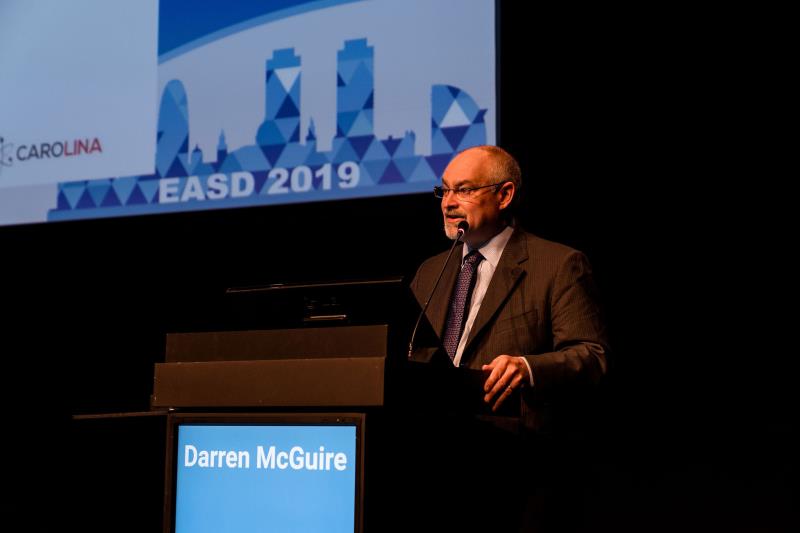 Professor Darren McGuire (Image courtesy of EASD)
Professor Darren McGuire (Image courtesy of EASD)The incidence of cardiovascular (CV) death, nonfatal myocardial infarction (MI), or nonfatal stroke (three-point MACE*) was comparable in individuals with early stage type 2 diabetes (T2D) who received the DPP-4** inhibitor linagliptin or the sulfonylurea glimepiride in addition to usual care, according to results of the CAROLINA*** trial.
“The current study demonstrates noninferior CV safety effects for linagliptin vs glimepiride when used predominantly as a second-line glucose-lowering treatment option after metformin,” said the researchers.
The multinational study involved 6,033 individuals (mean age 64 years, 39.9 percent female) with early T2D (mean duration 6.3 years, mean HbA1c 7.2 percent) and high CV risk who, in addition to receiving usual care, had been randomized 1:1 to receive linagliptin (5 mg QD) or glimepiride (uptitrated every 4 weeks from 1 mg to maximum 4 mg QD). Forty-two percent of patients had atherosclerotic CVD at baseline. Patients were followed up for a median 6.3 years.
The occurrence of the three-point MACE was comparable between patients who received linagliptin and glimepiride (11.8 percent vs 12.0 percent; hazard ratio [HR], 0.98, 95.47 percent confidence interval [CI], 0.84–1.14; pnoninferiority<0.001, psuperiority=0.76). [EASD 2019, S42; JAMA 2019;doi:10.1001/jama.2019.13772]
All-cause mortality did not differ between linagliptin and glimepiride recipients (10.2 percent vs 11.2 percent; HR, 0.91; p=0.23), nor did CV or non-CV death (5.6 percent each; HR, 1.00; p=0.99 [CV death] and 4.6 percent vs 5.6 percent; HR, 0.82; p=0.08 [non-CV death]). There was a trend toward earlier introduction of additional glucose-lowering agents in the linagliptin vs the glimepiride group, and modest weight gain in the glimepiride group (between-group difference, -1.54 kg).
Adverse events (AEs) and serious AEs occurred at a similar rate between linagliptin and glimepiride recipients (93.6 percent vs 95.2 percent [AEs] and 46.4 percent vs 48.1 percent [serious AEs]). A comparable proportion of patients in both groups discontinued study drug due to AEs (13.7 percent vs 14.9 percent). Linagliptin and glimepiride recipients also had similar incidence of acute pancreatitis (0.5 percent each) and pancreatic cancer (0.5 percent vs 0.8 percent).
Hypoglycaemia occurred less frequently among linagliptin compared with glimepiride recipients (10.6 percent vs 37.7 percent; HR, 0.23, 95 percent CI, 0.21–0.26), specifically moderate or severe hypoglycaemia (HR, 0.18) and hospitalization due to hypoglycaemia (HR, 0.07; p<0.001 for all).
“Linagliptin has proven CV safety vs glimepiride, with lower risk for hypoglycaemia or weight gain,” said study co-author Professor Darren McGuire from the University of Texas Southwestern Medical Center, Dallas, Texas, US.
Addressing the CV safety of sulfonylureas
“Despite their long clinical experience and very low cost, the less-favoured status of sulfonylureas is due mainly to AEs of weight gain and risk for hypoglycaemia, as well as long-standing uncertainty regarding their CV safety,” said Dr Deborah Wexler from Massachusetts General Hospital, Harvard Medical School, Boston, Massachusetts, US, in an editorial. [JAMA 2019;doi:10.1001/jama.2019.14533]
“Providers and patients can now be assured about the CV safety of glimepiride. We can prove with great precision and certainty that there is no incremental CV risk associated with glimepiride when compared with linagliptin,” said McGuire. Based on the data from CAROLINA and CARMELINA#, “the FDA should revisit the glimepiride product-label warnings for increased CV mortality.”
However, given the potential heterogeneity across the sulfonylurea class pertaining to CV safety, it remains uncertain if the safety demonstrated with glimepiride extends to other sulfonylureas, he said.
The findings for linagliptin may also not apply to patients with more advanced T2D, given that those on insulin were excluded, added the researchers.